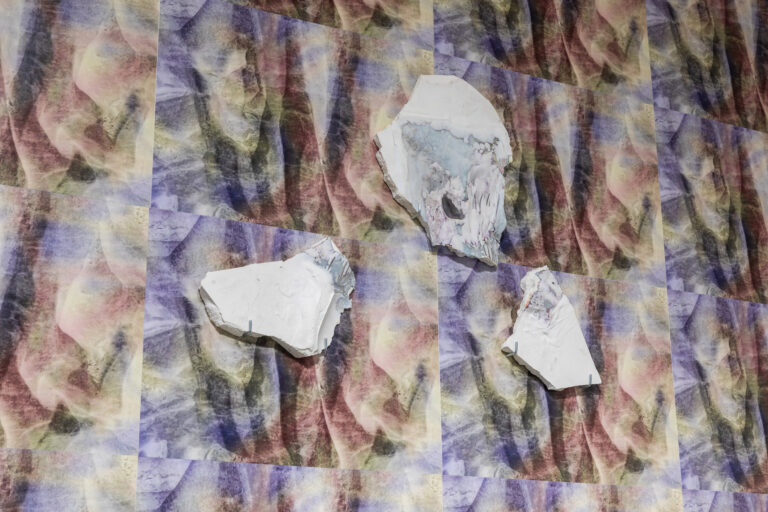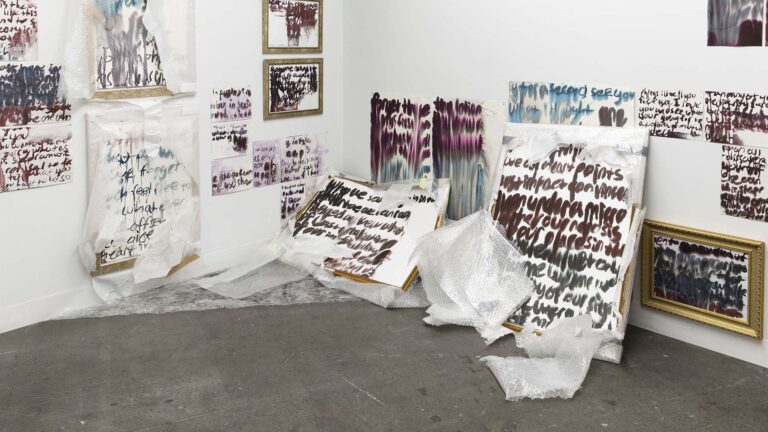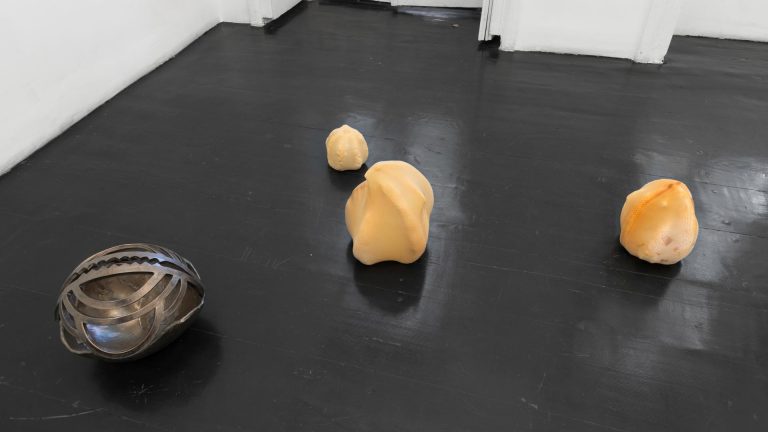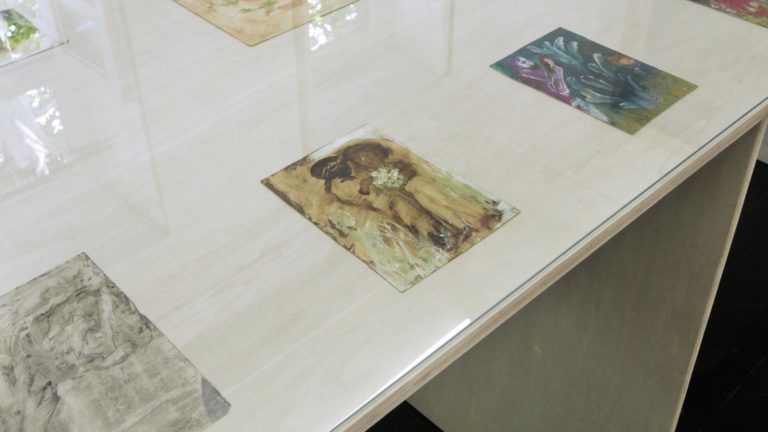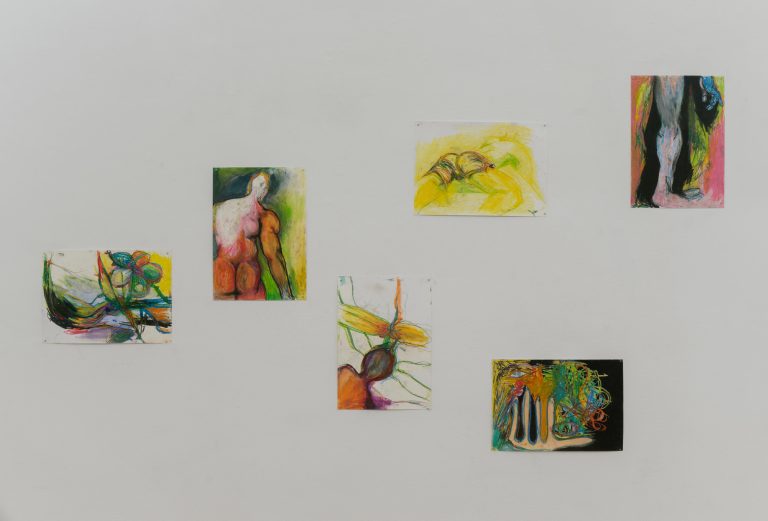Artist: Tamaz Nutsubidze
Venue: LC Queisser, Tbilisi, Georgia
Date: September 11 – October 24, 2021
Photography: all images copyright and courtesy of the artists and LC Queisser
LC Queisser, in collaboration with Nectar Gallery, hosts the exhibition of the late artist Tamaz Nutsubidze (1940-2002), presenting the re-completed series of decorative textile and tapestry work alongside rich archive material.
Amongst the fellow pioneers, Nutsubidze attended the newly founded Textile Department at the Tbilisi State Academy of Arts in 1959, established in the means of updating the educational system and rescuing the institution from shutting down. Instead of following the prefigured interest in graphics, he pursued textile design, sensing the broader possibility of alternative artistic freedom in the field of decorative and applied arts to escape the rigid Soviet grip on fine arts, enforcing socialist realism and its pictorial solace. Many found shelter in the decorative field, as there was a loophole in the hierarchical dispositioning of art forms. This was a chance to have a fresh take on a long weaving tradition, redefining the heavily industrialized medium to become more artistic and contemporary in form while going back to the roots of the folk practice, analyzing its aesthetic value and logic. Lack of systemization of carpets’ ethnic origin in Transcaucasus, accompanied with the cultural assimilation of Soviet-era, causes the XX century domestic tapestry, as a modern interpretation of the folk carpet, to become more and more culturally crossbreed and therefore contextually abstracted. Nutsubidze researches kilims and carpets from the Georgian eastern mountain region (Tusheti, Alvani, Pshavi, Khevsureti, Kazbegi). The work Tushetian Motives, 1978 is an insightful representation of the artistic effort of individuation through local research and compositional decoding. A navy blue wool flatweave is rationally built and decorated with geometric motifs, such as moderated Memling gül found on Borchalo rugs and sharp 90-degree hooks, maintaining the graphical and linear expressiveness affiliated with the mountain tradition and Georgian folk costume. The elegant coloring scheme consists of limited natural tones, such as dark blue, white, yellow, and wine, inherent to the Tusheti convention and its isolating but calming essence. The compositional laconism of the piece is an appropriate modern take on folk medium, staying authentic to the element of pixel-organized space.
Nutsubidze suggests tapestry as essentially a flat form of painting, appreciating the duality of the medium in its practical and ideological sense, allowing his works to go beyond decorative and the context in which they were produced. Having a Baltic influence, Nutsubidze rejects the realistic dimensional technique, distancing himself from the figuration and Soviet craze of depicting perspective, not forcing painting techniques on a Gobelin. The pure exploration of the color and form and absolute emancipation of the idea from its collectively assigned icons reaches the peak in his 1988’s tapestry series Seasons of the Year. Composed of four seasonal pieces, two of which – Winter and Spring’s whereabouts are uncertain, were reproduced for the exhibition by his son, Beka Nutsubidze, using the original sketches of Nutsubidze and the leftover organic material that is now rare to come across. This is the first occasion when all four works are shown all together in one space.
The common theme of time, recurring in many Baltic artists’ works, mainly in Latvia, also appears here with Nutsubidze, represented in constant alterations between seasons, sunset-dawn, darkness-light, and more. The visual conceptualization of time is in gradual metamorphosis throughout his practice. In his prior works, he touched upon the different stages of the day, one of the examples being 1978’s rug piece Night, which bears a resemblance to the tapestries and sketches made with Tusheti motifs. The plane of varying tones of blue is split in the middle with a moonlight-colored diamond shape, while smaller diamonds are scattered along the vertical line and fixed on the west and east poles of the wool pile rug. Nutsubidze extended his investigation of parallelism within the axis of color and composition. The artist explores the phenomenon of gradation, opposites, and the quintessential unity of the passing, present, and future moments. To show the recurrency of episodes between Winter, Spring, Summer, and Autumn, the designs are reconstructed in interchangeable variables, evident in his alterations in the preparatory sketches of the seasonal series. From the Mathematical principle of multiplication, involved in fiber weaving to the coloristic and spatial deconstruction of infinite, the arranged linear strands of color, similar to verses of the poetry, form a metaphysical rhyme of hypnotic harmony. Strong blocks of color are kept hidden with a curtain-like layer of fine sisal knots, while bare-left constructivist accents create a strong frame, similar to analog film edges. This simple but astute use of knotting on the tapestry creates an illusion of a perfect gradience through dense transparent layers of hand-dyed sisal yarns. The experimental decision of texture puts the planar understanding of textile art to the rest. Yet firm but extremely fluid, Nutsubidze shows an unconventional grasp of the medium.
Georgian tapestry has always had an exhibition and decoration purpose, utilitarian and artistic, intended for architectural interiors of public establishments. Starting from the 60s, this kind of applied art was supported throughout soviet nations; artistic tapestries were mainly decorating public interiors, restaurants, hotels, public halls, and lobbies. With the growing demand for public decorations, Gobelin became essential, but more importantly, a synthetic medium, which allowed the artist to fully take over the space, from the interior architecture to the last miniature detail, mirroring the integral structural algorithm of a woven piece. Nutsubidze decorated plenty of memorable spaces: Restaurant Dariali, Tbilisi, Krtsanisi Government Residence, Tbilisi, Olympic Games, Moscow, Fedorov Ophthalmologist clinic, Moscow, Rustavi Theater, Rustavi, Center for Symphonic Music, Tbilisi. Sorting through his archives, we find photo documentation of mesmerizing interiors he curated and get a sense of his contemporary approach to space with the full hybridity of a multimedia artist. The artist experimented with graphics – making acute sketches in gouache for his textile projects, manipulating the idea various times, though still living space to improvise during the production process. His ingenious drawings are characterized by the realistic textures of textile while remaining in the matrix of two-dimensionality. Nutsubidze embodied the medium and gave it desired freedom to flourish in its truest capacious form. Alongside other experiments, he researched printing, reformulating techniques of traditional Georgian Supras, and designed book covers. Some of Nutsubidze’s later gouache works draw inspiration from Soviet mosaics and the muralistic works of the 1920s, as seen in the distinctive features of decorative figures while carrying out the essence of the Soviet monumental posters. The artist is a prominent figure, not only in Georgian but in the Soviet art scene of the twentieth century. Tamaz Nutsubidze’s life-long practice reflects the tendencies of the milieu, Georgian heritage, and local identity while making artistic discoveries in his timeless abstractions.
The list of various exhibitions in which he participated include Republic exhibition of applied-decorative art, Tbilisi, 1967; USSR exhibition of decorative art at Manege, Moscow, 1968; Exhibition of decorative art of Soviet Union, Berlin, 1969; USSR exhibition of tapestry, Moscow, 1971; USSR II exhibition of the tapestry, Riga, 1974; USSR exhibition Manege, Moscow, 1974; Various Republic exhibitions of Georgian Tapestry in Tbilisi; USSR exhibition Manege, Moscow, 1986; Personal exhibition, Mziuri, Tbilisi, 1992; Republic exhibition dedicated to the 30th Anniversary of Georgian Tapestry, Tbilisi, 1997; I/II/III textile forum, Tbilisi, 1997/1999/2001; Exhibition at UN House, Tbilisi, 2000; International Tapestry Art Exhibition (from Lausanne to Beijing), 2000; The opening of the Tapestry Museum, Tbilisi, 2001; Solo show at The National Gallery, Tbilisi, 2002; Solo show at Tbilisi State Fine Art Academy, 2010; LISTE Basel, Switzerland, 2014 and Gallery Nectar, Tbilisi, 2018. Tamaz Nutsubidze continued his relationship with the Tbilisi State Fine Art Academy as a lecturer at the Textile Department, then moving on as a dean of the Department of Tapestry and Artistic Textiles from 1995 until he died in 2002.
A special thanks to Beka Nutsubidze for reproducing the works Winter and Spring in collaboration with the gallery.
Tamaz Nutsubidze, 2021, exhibition view, LC Queisser, Tbilisi
Tamaz Nutsubidze, 2021, exhibition view, LC Queisser, Tbilisi
Tamaz Nutsubidze, 2021, exhibition view, LC Queisser, Tbilisi
Tamaz Nutsubidze, 2021, exhibition view, LC Queisser, Tbilisi
Tamaz Nutsubidze, Shemodgoma (Autumn), 1988, Wool and sisal, 247 x 162 cm
Tamaz Nutsubidze, 2021, exhibition view, LC Queisser, Tbilisi
Tamaz Nutsubidze, 2021, exhibition view, LC Queisser, Tbilisi
Tamaz Nutsubidze, 2021, exhibition view, LC Queisser, Tbilisi
Tamaz Nutsubidze, 2021, exhibition view, LC Queisser, Tbilisi
Beka Nutsubidze, Tamaz Nutsubidze, Zamtari (Winter), 1988/2021, Wool and sisal, 257 x 157 cm
Tamaz Nutsubidze, 2021, exhibition view, LC Queisser, Tbilisi
Tamaz Nutsubidze, 2021, exhibition view, LC Queisser, Tbilisi
Tamaz Nutsubidze, 2021, exhibition view, LC Queisser, Tbilisi
Beka Nutsubidze, Tamaz Nutsubidze, Gazaphkhuli (Spring), 1988/2021, Wool and sisal, 246 x 158 cm
Tamaz Nutsubidze, Zaphkhuli (Summer), 1988, Wool and sisal, 247 x 164 cm
Tamaz Nutsubidze, 2021, exhibition view, LC Queisser, Tbilisi
Tamaz Nutsubidze, 2021, exhibition view, LC Queisser, Tbilisi
Tamaz Nutsubidze, 2021, exhibition view, LC Queisser, Tbilisi
Tamaz Nutsubidze, 2021, exhibition view, LC Queisser, Tbilisi
Tamaz Nutsubidze, 2021, exhibition view, LC Queisser, Tbilisi
Tamaz Nutsubidze, Ghame (Night), 1978, Wool, 247 x 139 cm
Tamaz Nutsubidze, 2021, exhibition view, LC Queisser, Tbilisi
Tamaz Nutsubidze, Ritmuli Kompozitsia (Rhythmical Composition), 1985, Gouache on cardboard, 25.5 x 38 cm
Tamaz Nutsubidze, 2021, exhibition view, LC Queisser, Tbilisi
Tamaz Nutsubidze, Promenade, 1978, Gouache on cardboard, 34 x 41 cm


























